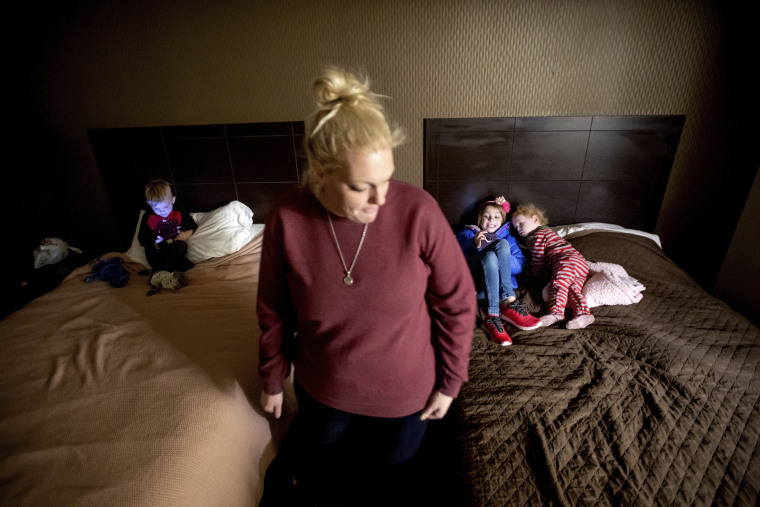Nearly a month after the deadliest and most destructive wildfire in recorded California history, residents will be allowed into some parts of the devastated town of Paradise to check on their homes or what remains of them, officials announced on Wednesday.
The milestone was treated with relief and a sense of hope among some of those whose homes burned in the so-called Camp Fire, which began on the morning of Nov. 8 and tore through parts of Paradise and other communities, killing at least 85 people. The cause of the fire is still under investigation.
"I've lived here my whole life, so I couldn’t imagine going anywhere else," said Jeff Hill, 29, who works for the Paradise Irrigation District who lost his home in the fire and who plans to rebuild in the town, which had a population of around 26,000.
Hill, as a utility worker who has been toiling to restore water service to the area, has seen the wreckage of his home in the northeast part of Paradise.
"You don’t really get the feeling until you see it for yourself, and your stomach drops when you see everything you own lying on the ground," he said.
The number of those unaccounted for in the wake of the fire has dropped to 10, Butte County Sheriff Kory L. Honea said Wednesday. The list of unaccounted for had been at more than 1,000 names a week after the fire broke out. The number of deaths had been said to be 88, but remains thought to be those of multiple people were confirmed by DNA to be the same victim, the sheriff's office said earlier this week.
Areas on the east side of Paradise were to be opened to residents only for 24 hours starting Wednesday, the town said. The fire destroyed vital infrastructure, and people were encouraged to ensure they have food, water and fuel for vehicles, and to be mindful of hazards and to watch out for utility crews when driving.
"We want nothing more than to be able to open this up and allow you to get back in there; it's not something that we relish," Honea said at a community meeting on Tuesday about recovery efforts and making areas safe for people to return.
The Camp Fire burned more than 153,000 acres and destroyed at least 13,972 homes, as well as hundreds of other commercial and other structures, according to the California Department of Forestry and Fire Protection. The fire was fully contained by Nov. 25.
Kevin Hannes, deputy federal coordinating officer for the Federal Emergency Management Agency, told residents on Tuesday that federal and state authorities are dedicated to helping the area recover. He said the average FEMA grant from the Camp Fire is around $10,000 and during recovery after Hurricane Harvey the average grant was around $4,500.
"I know what it’s like to lose a house to a fire. I don’t know what it’s like to lose a whole town," Hannes said. "But I do know what it’s like to build a whole town, because we’ve done it before ... This agency, in coordination with Cal OES, is here to ensure that not only Paradise [but] Concow, Magalia will rise from the ashes."
Authorities have so far identified more than 100 trailer pads for FEMA travel trailers along a corridor from Redding to Sacramento, Hannes said. He said that more than $33 million has been approved for fire survivors.
"I want to assure people, we’re not going to start moving people to Nevada or to Southern California," Hannes said. "We are looking to keep individual families here as close to Butte County as we can."

Another task will be the cleanup of debris in the wake of the fire. Mark Ghilarducci, director of the California Office of Emergency Services, said at Tuesday’s meeting that it “is going to be the largest debris operation that the state has ever seen."
Ghilarducci said that he said the same thing in last year’s wildfires in Sonoma County, and in that case “we removed enough debris to make two Golden Gate Bridges, if you can imagine. In this case, we are at least four times as much debris."
"It will take a Herculean effort to be able to effectively, safely and rapidly get all of the debris out of the area," he said, adding that state, federal and local teams are already being deployed to address household hazardous waste, and clearing all that hazardous waste could take four to six months.
Paradise Mayor Jody Jones called the opening of parts of the town "a great milestone," and said she is confident the town will rebuild and recover, although it may take time. She also lost her home in the fire.
"I think it shows there as a lot of hope coming for our community, and it’s the first of many milestones to come," she said Wednesdsay.
More than 50,000 people were evacuated due to the fire, officials have said. Housing is an issue, Jones said, noting that the damage was unprecedented and that so many people were displaced in a rural area without a lot of alternate housing. “I don’t know what more that they can be doing” she said of the federal response.
There are still around 1,700 structures standing in Paradise, and she said that people living there could start to return in the next few months.
"I think more normal will be two years from now when those people whose homes have burned down are able to move into rebuilt homes," Jones said.
"It’s going to be all brand new, it's going to be beautiful,” she said. "It's going to be Paradise."


